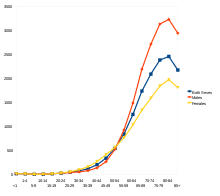Aging-associated diseases
An aging-associated disease is a disease that is most often seen with increasing frequency with increasing senescence. Essentially, aging-associated diseases are complications arising from senescence. Age-associated diseases are to be distinguished from the aging process itself because all adult animals age, save for a few rare exceptions, but not all adult animals experience all age-associated diseases. Aging-associated diseases do not refer to age-specific diseases, such as the childhood diseases chicken pox and measles. "Aging-associated disease" is used here to mean "diseases of the elderly". Nor should aging-associated diseases be confused with accelerated aging diseases, all of which are genetic disorders.
Examples of aging-associated diseases are atherosclerosis and cardiovascular disease, cancer, arthritis, cataracts, osteoporosis, type 2 diabetes, hypertension and Alzheimer's disease. The incidence of all of these diseases increases rapidly with aging (increases exponentially with age, in the case of cancer).

Of the roughly 150,000 people who die each day across the globe, about two thirds—100,000 per day—die of age-related causes.[1] In industrialized nations, the proportion is higher, reaching 90%.[1]
Patterns of differences
By age 3 about 30% of rats have had cancer, whereas by age 85 about 30% of humans have had cancer. Humans, dogs and rabbits get Alzheimer's disease, but rodents do not. Elderly rodents typically die of cancer or kidney disease, but not of cardiovascular disease. In humans, the relative incidence of cancer increases exponentially with age for most cancers, but levels off or may even decline by age 60–75 (although colon/rectal cancer continues to increase).[2]
Victims of some of the so-called segmental progerias are vulnerable to different sets of diseases. Victims of Werner's syndrome suffer from osteoporosis, cataracts and cardiovascular disease, but not neurodegeneration or Alzheimer's disease. Victims of Down syndrome suffer type 2 diabetes and Alzheimer's disease, but not high blood pressure, osteoporosis or cataracts. Victims of Bloom syndrome most often die of cancer.
Research
Aging (senescence) increases vulnerability to age-associated diseases, whereas genetics determines vulnerability or resistance between species and individuals within species. Some age-related changes (like graying hair) are said to be unrelated to an increase in mortality. But some biogerontologists believe that the same underlying changes that cause graying hair also increase mortality in other organ systems and that understanding the incidence of age-associated disease will advance knowledge of the biology of senescence just as knowledge of childhood diseases advanced knowledge of human development.[3]
Strategies for Engineered Negligible Senescence (SENS) is a research strategy which aims to repair a few "root causes" for age-related illness and degeneration, as well as develop medical procedures to periodically repair all such damage in the human body, thereby maintaining a youth-like state indefinitely.[4] So far, the SENS programme has identified seven types of aging-related damage, and feasible solutions have been outlined for each. However, critics argue that the SENS agenda is optimistic at best, and that the aging process is too complex and little-understood for SENS to be scientific or implementable in the foreseeable future.[5][6][7]
See also
References
- 1 2 Aubrey D.N.J, de Grey (2007). "Life Span Extension Research and Public Debate: Societal Considerations" (PDF). Studies in Ethics, Law, and Technology. 1 (1, Article 5). doi:10.2202/1941-6008.1011. Retrieved August 7, 2011.
- ↑ "SEER Cancer Statistics Review, 1975–2003" (PDF). Surveillance Epidemiology and End Results (SEER). National Cancer Institute. Archived (PDF) from the original on 2006-09-25. Retrieved 2006-11-20.
- ↑ Hayflick, L (2004). "The not-so-close relationship between biological aging and age-associated pathologies in humans". THE JOURNALS OF GERONTOLOGY: Series A BIOLOGICAL SCIENCES AND MEDICAL SCIENCES. 59 (6): B547–B550. doi:10.1093/gerona/59.6.B547. PMID 15215261.
- ↑ "The SENS Platform: An Engineering Approach to Curing Aging". Methuselah Foundation. Retrieved on June 28, 2008.
- ↑ Warner, H; Anderson, J; Austad, S; Bergamini, E; Bredesen, D; Butler, R; Carnes, BA; Clark, BF; et al. (2005). "Science fact and the SENS agenda". EMBO Reports. 6 (11): 1006–8. doi:10.1038/sj.embor.7400555. PMC 1371037
 . PMID 16264422.
. PMID 16264422. - ↑ De Grey, AD (2005). "Like it or not, life-extension research extends beyond biogerontology". EMBO Reports. 6 (11): 1000. doi:10.1038/sj.embor.7400565. PMC 1371043
 . PMID 16264420.
. PMID 16264420. - ↑ de Grey, Aubrey. "The biogerontology research community's evolving view of SENS". Methuselah Foundation. Retrieved on July 1, 2008.